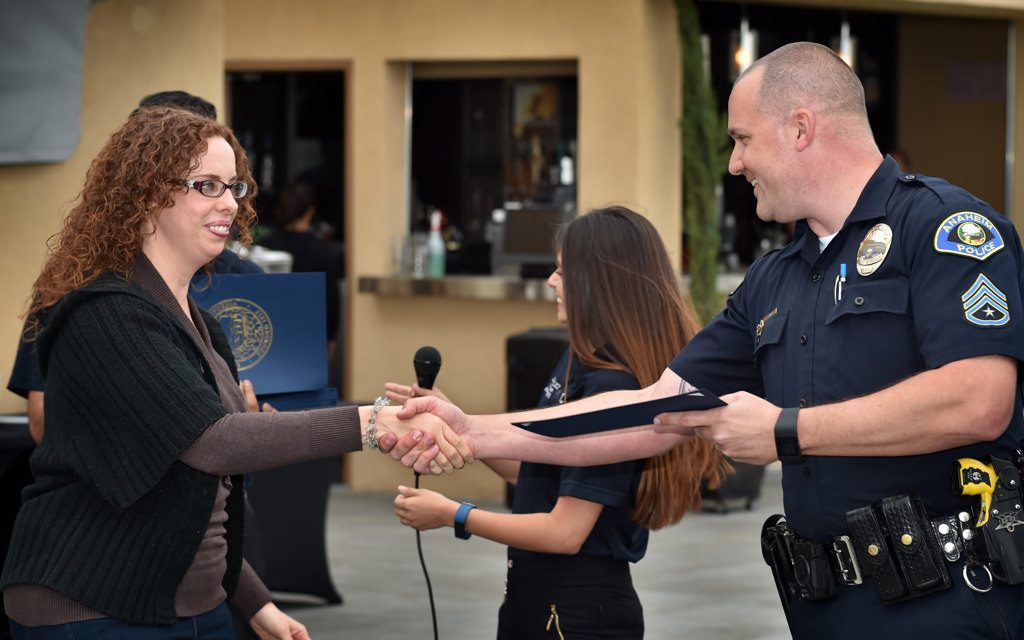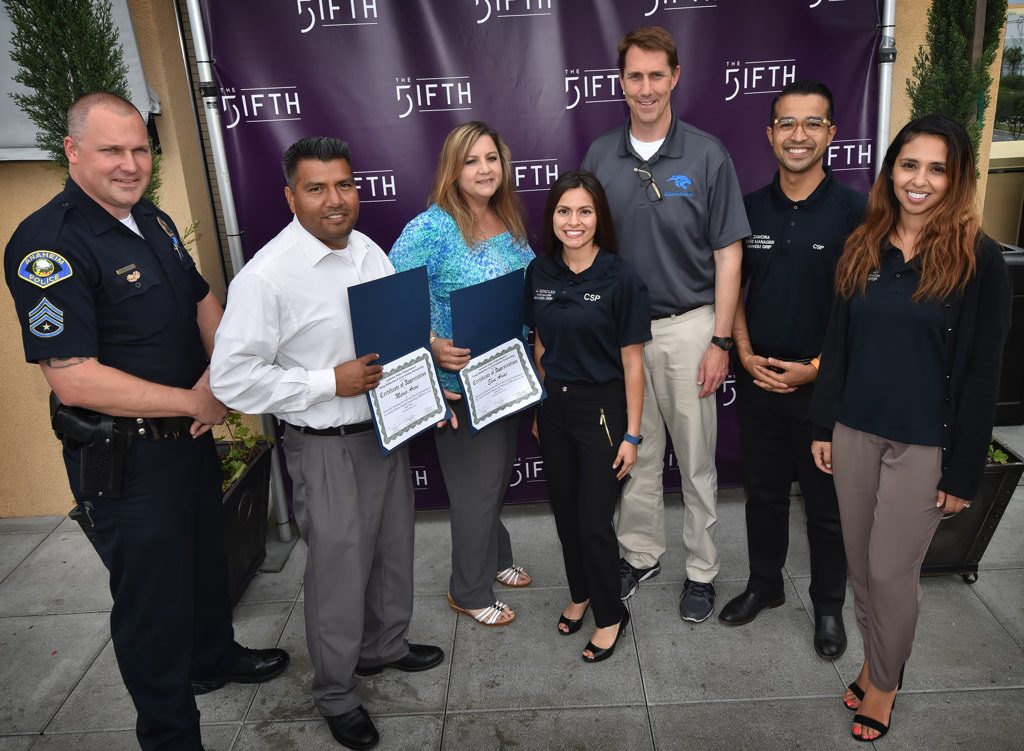Several selfless Anaheim teachers are influencing young lives outside the classroom.
As volunteer mentors in Anaheim’s Gang Reduction Intervention Partnership, commonly known as GRIP, the teachers provide one-on-one mentorships to students in fourth through eighth grades whose lives hang in the balance because of poor decision-making.
In place at 12 Anaheim schools, GRIP uses a multipronged approach to effect lasting change. Teachers, parents, administrators and the police all play a role.

Trent Speier of South Junior High, right, receives an Anaheim Police Department’s Gang Reduction & Intervention Partnership Certificate of Appreciation from Anaheim PD Sgt. Brennan Leininger as teachers are honored at a gathering at the Grand Legacy at the Park Hotel in Anaheim.
Photo by Steven Georges/Behind the Badge OC
By serving as role models and sharing their own life experiences on their own time, teacher-mentors aim to reach impressionable GRIP students, many who are at risk of joining gangs.
The teachers were given certificates of appreciation during an event at the Grand Legacy at the Park Hotel May 11.

Teachers gather on the fifth floor of the Grand Legacy at the Park Hotel in Anaheim as they are honored by Anaheim PD and GRIP of Anaheim.
Photo by Steven Georges/Behind the Badge OC
“As teachers, you know more than anybody else how important being a mentor and a positive role model is to the success of these kids,” Anaheim PD Sgt. Brennan Leininger told the honorees. “What you do is amazing, and it’s a vital component to the GRIP organization.”
Anaheim GRIP started 10 years ago in two schools, said Kristen Gaborno, program director for GRIP and Juvenile Diversion for Community Services Programs (CSP).
CSP serves children, adults and families living in Orange County, including abused children, struggling families, victims of crime, and those in need of mediation services.

Regina Guastamacchio of Thomas Edison Elementary, left, receives an Anaheim Police Department’s Gang Reduction & Intervention Partnership Certificate of Appreciation from Anaheim PD Sgt. Brennan Leininger.
Photo by Steven Georges/Behind the Badge OC
Nick Greco, a special education teacher at South Jr. High School, is serving as a mentor for the second time.
“It allows us to interact in a setting other than the classroom,” Greco said. “It’s another way that we can reach our students.”
Greco said his mentee is a “smart kid” and just needs to have a routine and structure.

Teachers from South Junior High gather with Fernando Zamora, right and Anaheim PD Sgt. Brennan Leininger, left, as they are honored by APD and GRIP (Gang Reduction Intervention Partnership).
Photo by Steven Georges/Behind the Badge OC
“He’s definitely got a lot of untapped potential,” Greco said. “I just give him the guidance and let him and his abilities take over from there. It’s very fulfilling when they are doing it and you know they’re on the right path.”
South teacher Manuel Camarena likens his role as a mentor to that of a “big brother.”
“Some of the stuff I’ve shared with him are from down in the root of life,” said Camarena, a first-time mentor. “I feel like I can relate to him and some of the things he’s going through.”
The 100 or so teacher-mentors meet with their mentees at least once a week, maybe have lunch or meet after school, usually in an informal setting outside the classroom.

Teachers from Danbrook Elementary, including Principal Erasmo Garcia, back row center, gather with Anaheim PD Sgt. Brennan Leininger, left, as they are honored by APD and GRIP (Gang Reduction Intervention Partnership).
Photo by Steven Georges/Behind the Badge OC
Watching the mentee change over the course of a school year is what’s most rewarding, said Jenni Camarena, also a first-time mentor.
“At first, she kind of put on that tough-girl front and then she opened up a lot to me,” Camarena said. “It’s rewarding to earn that trust and have them trust you.”
But not all the GRIP students are necessarily in danger of joining gangs, said Joan Barnes, one of 22 teacher-mentors at Danbrook Elementary School.

Teachers from Lincoln Elementary gather with V. Saldivar and Lolly Domond of Anaheim GRIP, right, and Anaheim PD Sgt. Brennan Leininger, left, as they are honored by APD and GRIP (Gang Reduction Intervention Partnership).
Photo by Steven Georges/Behind the Badge OC
“Sometimes it’s kids who might feel that they don’t fit in, and we just want to try to make them feel a little more attached to their school,” said Barnes, who is mentoring twins this year.
Danbrook mentors also have taken the program a step further by organizing monthly events in which the mentors and mentees get together for a group activity.
The idea is for mentees, who might sometimes feel isolated, to see that they’re not alone, Barnes said.
“It’s been a really good year because we’ve added that one aspect, as far as all of us coming together in addition to the one-on-one mentoring,” Barnes said. “It’s developed a little more each year.”

Teachers from Patrick Henry Elementary gather with V. Saldivar and Lolly Domond of Anaheim GRIP and Anaheim PD Sgt. Brennan Leininger, left, as they are honored by APD and GRIP (Gang Reduction Intervention Partnership).
Photo by Steven Georges/Behind the Badge OC

Teachers from Orangeview Junior High gather with J. Gonzalez, Fernando Zamora, and Lolly Domond of Anaheim GRIP and Anaheim PD Sgt. Brennan Leininger, left, as they are honored by APD and GRIP (Gang Reduction Intervention Partnership).
Photo by Steven Georges/Behind the Badge OC

Teachers from Thomas Edison Elementary gather with Anaheim PD Sgt. Brennan Leininger, left, as they are honored by APD and GRIP (Gang Reduction Intervention Partnership).
Photo by Steven Georges/Behind the Badge OC
 Behind the Badge
Behind the Badge



